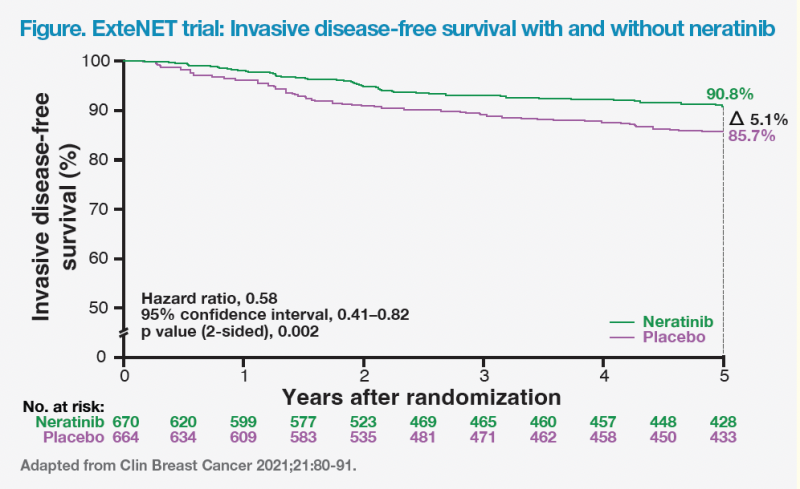Role of extended adjuvant therapy in minimizing recurrence risk in HR+/HER2+ breast cancer





Pathological complete response (pCR) to earlier therapy is one of the key prognostic factors in patients with HER2-positive (HER2+) breast cancer (BC), which can help inform subsequent treatment decisions. In an interview with MIMS Oncology, Dr Joyce Lee, Specialist in Oncology in private practice in Hong Kong, discusses pCR and factors associated with disease recurrence, as well as data supporting the use of neratinib, an irreversible, small-molecule pan-HER tyrosine kinase inhibitor (TKI), as extended adjuvant therapy in hormone receptor–positive (HR+)/HER2+ BC.
pCR as a prognostic marker
A pooled analysis of 11 neoadjuvant trials (n=3,710) showed that pCR in patients with HER2+ BC is associated with an approximately 80 percent reduction in the risk of recurrence. [J Clin Oncol 2023;41:2998-3008]
“Not achieving pCR is associated with a higher risk of recurrence and generally poorer long-term outcomes, especially in patients with larger tumour size and primary nodal involvement,” said Lee. In addition, younger patients with higher recurrence risk characteristics, including higher histological grading, Ki-67 expression and proportion of vascular invasion, have worse prognosis than older patients. [Clin Breast Cancer 2023;23:350-362]
“While it is a useful marker in HR+/ HER2+ disease, involvement of the endocrine pathway means that pCR does not tell the whole story, and there are cases where it does not correlate with long-term survival,” she noted.
What to do if pCR is not achieved?
“For patients with HR+/HER2+ BC with tumours ≥2 cm or lymph node [LN] involvement, the standard of care is neoadjuvant therapy with chemotherapy and dual HER2-targeted therapy. After surgery, which may be breast-conserving or a mastectomy, depending on the individual case, patients would continue HER2-targeted therapy for up to a year,” said Lee.
However, even with optimal neoadjuvant and adjuvant therapy, including trastuzumab-based regimens, distant recurrences are not uncommon with longer follow-up. Although the addition of trastuzumab to adjuvant chemotherapy has been shown to extend overall survival (OS) in patients with HER2+ disease, up to 31 percent of them experience recurrence and/or die within 10 years of treatment. [Ann Oncol 2024;35:159-182; Breast Care (Basel) 2021;16:664-676]
The open-label phase III KATHERINE study compared adjuvant trastuzumab and trastuzumab emtansine (T-DM1) in 1,486 patients with HER2+ early BC who were found to have residual invasive disease in the breast or axilla at surgery after receiving neoadjuvant therapy containing a taxane (with or without anthracycline). T-DM1 demonstrated a 50 percent reduction in risk of recurrence or death vs trastuzumab. However, the risk of recurrence with adjuvant T-DM1 remained substantial, with 11.7 percent of patients relapsing at 3 years. [Oncol Ther 2021;9:297-309]
Furthermore, a subset of patients in the KATHERINE trial experienced central nervous system (CNS) recurrence as their first event (5.9 percent in the T-DM1 group and 4.3 percent in the trastuzumab group). The remaining risk of recurrence, including in the CNS, despite T-DM1 treatment highlights the need for extended adjuvant strategies. [N Engl J Med 2019;380:617-628; Cancer Treat Rev 2021;99:102229]
“For patients with residual disease, adjuvant and extended adjuvant therapy offer an important opportunity to improve outcomes for these high-risk patients,” stated Lee. “Neratinib is a valuable option for HR+/HER2+ patients at high risk of recurrence.”
In the phase III ExteNET trial (n=2,840), patients with HER2+ early BC who initiated neratinib ≤1 year after trastuzumab-based therapy demonstrated an absolute 5-year invasive disease-free survival (iDFS) benefit of 5.1 percent (hazard ratio, 0.58; 95 percent confidence interval [CI], 0.41– 0.82) and an absolute 8-year OS benefit of 2.1 percent (hazard ratio, 0.79; 95 percent CI, 0.55–1.13) vs placebo. (Figure) Among patients with residual disease after neoadjuvant treatment (non-pCR subgroup; n=295), absolute 5-year iDFS and 8-year OS gains with neratinib were 7.4 percent (hazard ratio, 0.60; 95 percent CI, 0.33–1.07) and 9.1 percent (hazard ratio, 0.47; 95 percent CI, 0.23–0.92), respectively. [Clin Breast Cancer 2021;21:80-91]

In addition, ExteNET demonstrated a lower 5-year cumulative incidence of first CNS recurrences with neratinib vs placebo (0.7 vs 2.1 percent), and more patients in the neratinib group were alive without a CNS recurrence at 5 years (98.4 vs 95.7 percent; hazard ratio for CNS-DFS, 0.41; 95 percent CI, 0.18–0.85). The potential CNS benefit was consistently shown across various high-risk subgroups, including node-positive patients and those who did not achieve pCR. [Clin Breast Cancer 2021;21:80-91]
“Use of extended adjuvant therapy addresses the issue of tumour dormancy, targeting cancer cells that may remain quiescent during initial treatment only to reactivate later. It may also overcome adaptive resistance mechanisms that develop during standard treatment,” explained Lee. [Exp Mol Med 2024;56:2382-2394]
Which patients may benefit from extended adjuvant therapy?
“Patient selection is multifactorial. We consider whether the patient received neoadjuvant therapy, the extent of residual disease, nodal involvement, tumour grade, and genomic risk, which helps personalize treatment. Extended endocrine therapy, which is tailored according to menopausal status – tamoxifen for premenopausal women or an aromatase inhibitor for postmenopausal women, sometimes with ovarian suppression – also plays an important part. Ultimately, treatment choice is about assessing risk and tailoring treatment to individual patient’s biology to achieve best possible outcomes,” said Lee.
In the ExteNET trial, the greatest benefit was observed in HR+/HER2+ patients who had residual disease and initiated neratinib within 1 year of completing trastuzumab therapy. “Indeed, use of extended adjuvant neratinib is supported by the Community Care Fund Medical Assistance Programme in these patients,” added Lee. [Items Supported by the CCF Medical Assistance Programmes: https://www.ha.org.hk/haho/ho/ccf/CCF_items_en.pdf]
The ongoing prospective, observational ELEANOR study is investigating real-world use of neratinib as extended adjuvant therapy in HER2+ early BC and may provide additional details on treatment outcomes in patients with different characteristics. [Breast Care (Basel) 2024;19:1-9]